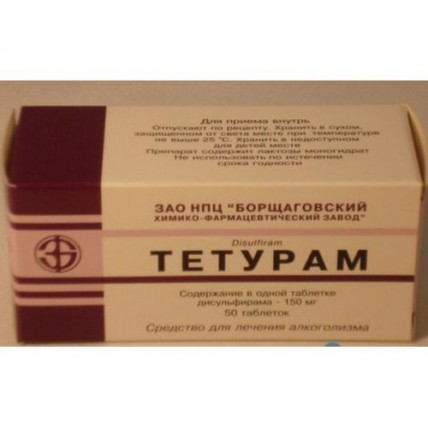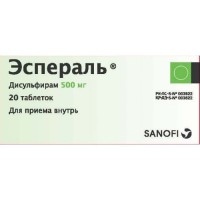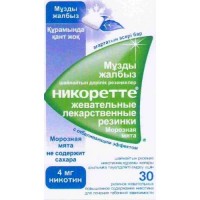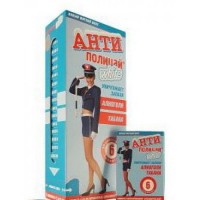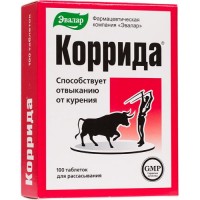TETURAM (Disulfiram) 150 mg, 50 tablets
- $14.00
Out Of Stock
The instruction
for medical use
of medicine
Teturamum
the Trade name
Teturamum
the International unlicensed
name Disulfiramum Dosage Form
of the Tablet of 150 mg
Structure
One tablet contains
active agent - Disulfiramum of 150 mg,
excipients: povidone, a macrogoal 6000, lactoses monohydrate, sodium of a kroskarmeloz, magnesium stearate
the Description
of the Tablet of color, white or white with slightly yellowish-greenish shade, round shape, with a flat surface with slanted edges (facet) and risky
Pharmacotherapeutic group
Drugs for treatment of diseases of nervous system others. Means for treatment of addictive disorders. Means for treatment of alcohol addiction. Disulfiramum.
The ATX N07BB01 code
the Pharmacological
Pharmacokinetics Later properties of intake happens fast, but not full (70-90%) absorption of drug in a digestive tract. Drug is quickly metabolized by restoration in diethyldithiocarbamate which is emitted in the form of a glucuronic conjugate, or transformed to diethyl amine and carbon sulfur which part (4-53%) is removed through lungs. The maximum therapeutic effect is reached in 12 h after oral administration and can proceed within 10-14 days after the treatment termination.
A pharmacodynamics
Means for treatment of an alcoholism. Inhibits the enzyme to an atsetaldegiddegidrogenaz participating in alcohol metabolism that leads to increase in concentration of ethyl aldehyde – an intermediate metabolite of ethanol. This metabolite is capable to cause a number of unpleasant feelings: rushes of blood suit, nausea, vomiting, feeling of an indisposition, tachycardia, a lowering of arterial pressure that does extremely unpleasant alcohol intake after administration of drug and allows to create a resistant negative conditioned reflex on a look and a smell of alcohol.
Indications
- an alcoholism in case of inefficiency of other methods of treatment
the Route of administration and doses
appoint Drug inside, in the morning on an empty stomach before a breakfast, for 0.45 - 0.75. Drug treatment is carried usually out according to the classical scheme.
The first Disulfiramum - alcoholic test will be out in 7-10 days from an initiation of treatment. After morning administration of drug, the patient accepts 20-30 ml of alcoholic drink, 40% of vodka are more often. Repeated tests in stationary conditions carry out in 1 - 2 day, is out-patient - in 3 - 5 days. At weak reaction, the dose of alcoholic drink is increased at the next test by 10 - 20 ml. Maximum dose of vodka of 100 - 120 ml. Within 1 – 3 years from an initiation of treatment the drug dose is gradually reduced to 0.15 - 0.3 g/days within 1-3 years.
In some cases treatment is carried out by the doctor according to the individual scheme.
Side effects
- metal smack in a mouth, nausea, vomiting, a halitosis, stomach aches, a diarrhea
- a polyneuritis of the lower extremities, an optic neuritis
- neuromental disturbances
- memory loss, confusion of consciousness, an asthenia, a headache, the increased fatigue, drowsiness, feeling sick
- skin allergic reactions
- collapse
- disturbances of a heart rhythm, arterial hypotension
- stenocardia
- a myocardial infarction, unexpected death, respiratory depression
- brain hypostasis
- intracranial bleedings
- spasms, encephalopathy
- an unpleasant smell at patients with colostomy (connected with formation of carbon sulfide)
- increase in level of transaminases in blood
- hepatitis cases, are possible fulminantny and fatal forms of hepatitis
of the Contraindication
- hypersensitivity to Disulfiramum
- a thyrotoxicosis
- diabetes
- a pronounced cardiosclerosis, atherosclerosis of brain vessels, before - and postinfarction states, an aortic aneurysm, coronary insufficiency, arterial hypertension of II and III stages, serious vascular diseases of a brain, heart and vascular diseases in a stage of a decompensation and others
- a pulmonary tuberculosis with a pneumorrhagia, fresh tubercular infiltrate
- bronchial asthma, the profound emphysema of lungs
- erosive defeats mucous digestive tract, ulcer belezn a stomach and a duodenum, bleeding from digestive tract
- a serious illness of a liver and kidneys, a liver failure
- belezn of the haematogenic bodies
- mental diseases
- infectious diseases of a brain
- epilepsy, an epileptiform syndrome
- polyneurites, neuritis of acoustical and eye nerves
- glaucoma
- malignant tumors
- pregnancy and the period of a lactation
- children's age up to 18 years
- age is more senior than 60 years
- an endarteritis
- earlier postponed disulfiramovy (antabusny) psychoses
Medicinal interactions
the Isoniazid: are possible a behavior disorder and coordination.
Nitromidazola (metronidazole, ordinazol, seknidazol, Tinidazolum): increase risk of development of disturbances of mentality, emergence of nonsense, delirious disorders, confusion of consciousness.
Phenytoinum: significant and fast increase in level of Phenytoinum in blood plasma with toxic manifestations (owing to oppression of his metabolism). If use of a similar combination cannot be avoided, it is necessary to make clinical observation and control of concentration of drug in blood plasma in time and after drug treatment.
Warfarin (with extrapolation on other oral anticoagulants): the increased effect of oral anticoagulants and danger of bleeding (decrease in metabolism of warfarin in a liver). More frequent control of level of a prothrombin and dose adjustment of anticoagulants in the course of treatment and within 8 days after Teturamum cancellation is recommended.
Theophylline: Teturamum breaks theophylline metabolism therefore the dose of theophylline has to be reduced taking into account clinical symptoms and concentration of drug in blood plasma.
Benzodiazepines: Teturamum can exponentiate sedation of benzodiazepines by inhibition of their oxidizing metabolism (especially chlordiazepoxide and diazepam). The dosage of benzodiazepine has to be a skorrigirovana according to klnichesky manifestations.
Tricyclic antidepressants: strengthening of reaction of intolerance of alcohol is possible.
The special
instructions Begin Treatment it is necessary under observation of the narcologist.
Teturamum is appointed only after comprehensive medical examination of the patient. The patient has to be informed of properties and features of effect of drug. It is necessary to warn patients about possible consequences of simultaneous alcohol intake or intake of the medicines containing ethanol.
With care to apply at patients with a renal failure, a hypothyroidism, diseases of a liver, a respiratory system (especially at a possibility of the simultaneous use with alcohol).
It is possible to appoint drug not earlier than in 12-24 h after the last alcohol intake.
Lactose is a part of drug therefore to patients with disturbances of tolerance to carbohydrates, such as congenital galactosemia, the syndrome of glyukozo-galaktozny malabsorption, a lactose intolerance, its use is not recommended.
Features of influence of medicine on ability to run the vehicle or potentially dangerous mechanisms
during drug treatment, it is necessary to refuse driving and potentially dangerous mechanisms.
The overdose
Overdose is observed at use of Teturamum and alcohol.
Symptoms: confusion of consciousness, coma, collapse, neurologic complications, hypostases, spasms.
Treatment: symptomatic, directed to restoration and maintenance of a functional condition of a cardiovascular and respiratory system, carry out disintoxication therapy, enter respiratory analeptics, group B vitamins.
Form of release and packing.
On 10 tablets in the blister from a film of polyvinylchloride and aluminum foil with a unilateral covering thermovarnish and the press on the other hand. On 1 or 5 blisters together with the instruction for medical use in the state and Russian languages place in a pack from cardboard.
To Store storage conditions in original packing at a temperature not above 25 °C.
To store out of children's reach!
4 years
not to use an expiration date after expiry date.
Prescription status
According to the prescription
the Public joint stock company Producer Borshchagovsky Chemical and Pharmaceutical Plant research and production center,
Ukraine, 03134, Kiev, Mira St., 17
the Owner of the registration certificate
Borshchagovsky Chemical and Pharmaceutical Plant research and production center Public joint stock company, Ukraine
the Address of the organization accepting in the territory of the Republic of Kazakhstan claims from consumers on quality of products (goods)
Representative office of PJSC NPC Borshchagovskiy HFZ in the territory of the Republic of Kazakhstan
050043, Almaty, the district of Orbit, 2, house 28, quarter 30
fax: +7 (272) 20-78-05, 55-18-53
E-mail:
To Develop vadimt58@list.ru
for medical use
of medicine
Teturamum
the Trade name
Teturamum
the International unlicensed
name Disulfiramum Dosage Form
of the Tablet of 150 mg
Structure
One tablet contains
active agent - Disulfiramum of 150 mg,
excipients: povidone, a macrogoal 6000, lactoses monohydrate, sodium of a kroskarmeloz, magnesium stearate
the Description
of the Tablet of color, white or white with slightly yellowish-greenish shade, round shape, with a flat surface with slanted edges (facet) and risky
Pharmacotherapeutic group
Drugs for treatment of diseases of nervous system others. Means for treatment of addictive disorders. Means for treatment of alcohol addiction. Disulfiramum.
The ATX N07BB01 code
the Pharmacological
Pharmacokinetics Later properties of intake happens fast, but not full (70-90%) absorption of drug in a digestive tract. Drug is quickly metabolized by restoration in diethyldithiocarbamate which is emitted in the form of a glucuronic conjugate, or transformed to diethyl amine and carbon sulfur which part (4-53%) is removed through lungs. The maximum therapeutic effect is reached in 12 h after oral administration and can proceed within 10-14 days after the treatment termination.
A pharmacodynamics
Means for treatment of an alcoholism. Inhibits the enzyme to an atsetaldegiddegidrogenaz participating in alcohol metabolism that leads to increase in concentration of ethyl aldehyde – an intermediate metabolite of ethanol. This metabolite is capable to cause a number of unpleasant feelings: rushes of blood suit, nausea, vomiting, feeling of an indisposition, tachycardia, a lowering of arterial pressure that does extremely unpleasant alcohol intake after administration of drug and allows to create a resistant negative conditioned reflex on a look and a smell of alcohol.
Indications
- an alcoholism in case of inefficiency of other methods of treatment
the Route of administration and doses
appoint Drug inside, in the morning on an empty stomach before a breakfast, for 0.45 - 0.75. Drug treatment is carried usually out according to the classical scheme.
The first Disulfiramum - alcoholic test will be out in 7-10 days from an initiation of treatment. After morning administration of drug, the patient accepts 20-30 ml of alcoholic drink, 40% of vodka are more often. Repeated tests in stationary conditions carry out in 1 - 2 day, is out-patient - in 3 - 5 days. At weak reaction, the dose of alcoholic drink is increased at the next test by 10 - 20 ml. Maximum dose of vodka of 100 - 120 ml. Within 1 – 3 years from an initiation of treatment the drug dose is gradually reduced to 0.15 - 0.3 g/days within 1-3 years.
In some cases treatment is carried out by the doctor according to the individual scheme.
Side effects
- metal smack in a mouth, nausea, vomiting, a halitosis, stomach aches, a diarrhea
- a polyneuritis of the lower extremities, an optic neuritis
- neuromental disturbances
- memory loss, confusion of consciousness, an asthenia, a headache, the increased fatigue, drowsiness, feeling sick
- skin allergic reactions
- collapse
- disturbances of a heart rhythm, arterial hypotension
- stenocardia
- a myocardial infarction, unexpected death, respiratory depression
- brain hypostasis
- intracranial bleedings
- spasms, encephalopathy
- an unpleasant smell at patients with colostomy (connected with formation of carbon sulfide)
- increase in level of transaminases in blood
- hepatitis cases, are possible fulminantny and fatal forms of hepatitis
of the Contraindication
- hypersensitivity to Disulfiramum
- a thyrotoxicosis
- diabetes
- a pronounced cardiosclerosis, atherosclerosis of brain vessels, before - and postinfarction states, an aortic aneurysm, coronary insufficiency, arterial hypertension of II and III stages, serious vascular diseases of a brain, heart and vascular diseases in a stage of a decompensation and others
- a pulmonary tuberculosis with a pneumorrhagia, fresh tubercular infiltrate
- bronchial asthma, the profound emphysema of lungs
- erosive defeats mucous digestive tract, ulcer belezn a stomach and a duodenum, bleeding from digestive tract
- a serious illness of a liver and kidneys, a liver failure
- belezn of the haematogenic bodies
- mental diseases
- infectious diseases of a brain
- epilepsy, an epileptiform syndrome
- polyneurites, neuritis of acoustical and eye nerves
- glaucoma
- malignant tumors
- pregnancy and the period of a lactation
- children's age up to 18 years
- age is more senior than 60 years
- an endarteritis
- earlier postponed disulfiramovy (antabusny) psychoses
Medicinal interactions
the Isoniazid: are possible a behavior disorder and coordination.
Nitromidazola (metronidazole, ordinazol, seknidazol, Tinidazolum): increase risk of development of disturbances of mentality, emergence of nonsense, delirious disorders, confusion of consciousness.
Phenytoinum: significant and fast increase in level of Phenytoinum in blood plasma with toxic manifestations (owing to oppression of his metabolism). If use of a similar combination cannot be avoided, it is necessary to make clinical observation and control of concentration of drug in blood plasma in time and after drug treatment.
Warfarin (with extrapolation on other oral anticoagulants): the increased effect of oral anticoagulants and danger of bleeding (decrease in metabolism of warfarin in a liver). More frequent control of level of a prothrombin and dose adjustment of anticoagulants in the course of treatment and within 8 days after Teturamum cancellation is recommended.
Theophylline: Teturamum breaks theophylline metabolism therefore the dose of theophylline has to be reduced taking into account clinical symptoms and concentration of drug in blood plasma.
Benzodiazepines: Teturamum can exponentiate sedation of benzodiazepines by inhibition of their oxidizing metabolism (especially chlordiazepoxide and diazepam). The dosage of benzodiazepine has to be a skorrigirovana according to klnichesky manifestations.
Tricyclic antidepressants: strengthening of reaction of intolerance of alcohol is possible.
The special
instructions Begin Treatment it is necessary under observation of the narcologist.
Teturamum is appointed only after comprehensive medical examination of the patient. The patient has to be informed of properties and features of effect of drug. It is necessary to warn patients about possible consequences of simultaneous alcohol intake or intake of the medicines containing ethanol.
With care to apply at patients with a renal failure, a hypothyroidism, diseases of a liver, a respiratory system (especially at a possibility of the simultaneous use with alcohol).
It is possible to appoint drug not earlier than in 12-24 h after the last alcohol intake.
Lactose is a part of drug therefore to patients with disturbances of tolerance to carbohydrates, such as congenital galactosemia, the syndrome of glyukozo-galaktozny malabsorption, a lactose intolerance, its use is not recommended.
Features of influence of medicine on ability to run the vehicle or potentially dangerous mechanisms
during drug treatment, it is necessary to refuse driving and potentially dangerous mechanisms.
The overdose
Overdose is observed at use of Teturamum and alcohol.
Symptoms: confusion of consciousness, coma, collapse, neurologic complications, hypostases, spasms.
Treatment: symptomatic, directed to restoration and maintenance of a functional condition of a cardiovascular and respiratory system, carry out disintoxication therapy, enter respiratory analeptics, group B vitamins.
Form of release and packing.
On 10 tablets in the blister from a film of polyvinylchloride and aluminum foil with a unilateral covering thermovarnish and the press on the other hand. On 1 or 5 blisters together with the instruction for medical use in the state and Russian languages place in a pack from cardboard.
To Store storage conditions in original packing at a temperature not above 25 °C.
To store out of children's reach!
4 years
not to use an expiration date after expiry date.
Prescription status
According to the prescription
the Public joint stock company Producer Borshchagovsky Chemical and Pharmaceutical Plant research and production center,
Ukraine, 03134, Kiev, Mira St., 17
the Owner of the registration certificate
Borshchagovsky Chemical and Pharmaceutical Plant research and production center Public joint stock company, Ukraine
the Address of the organization accepting in the territory of the Republic of Kazakhstan claims from consumers on quality of products (goods)
Representative office of PJSC NPC Borshchagovskiy HFZ in the territory of the Republic of Kazakhstan
050043, Almaty, the district of Orbit, 2, house 28, quarter 30
fax: +7 (272) 20-78-05, 55-18-53
E-mail:
To Develop vadimt58@list.ru
